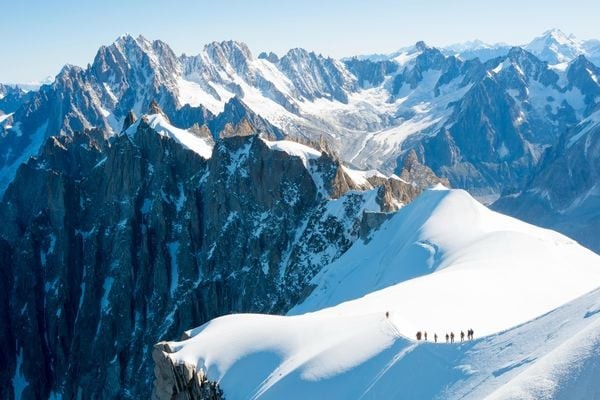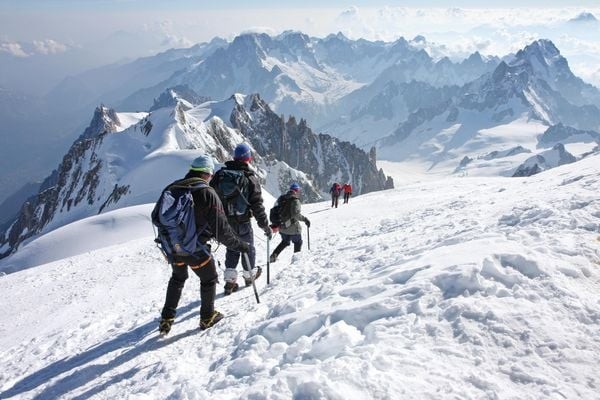Can I Climb Mont Blanc Without A Guide is a question many aspiring mountaineers ask. At CONDUCT.EDU.VN, we explore the realities of this challenge, offering insights into the skills, dangers, and regulations involved. Learn more about alpine mountaineering and the expertise required for a safe ascent, focusing on climbing independently and self-sufficiently, which can be daunting.
1. Understanding Mont Blanc and Its Challenges
Mont Blanc, standing at 4,808 meters (15,774 feet), is the highest peak in the Alps and Western Europe. While not technically the most challenging mountain in the world, it presents several significant obstacles that climbers must be prepared for. These include:
- Altitude: The high altitude leads to a decrease in oxygen levels, which can cause altitude sickness. Symptoms range from headaches and nausea to life-threatening conditions like high-altitude pulmonary edema (HAPE) and high-altitude cerebral edema (HACE).
- Weather: The weather on Mont Blanc can change rapidly and drastically. Clear skies can quickly turn into blizzards, with strong winds and near-zero visibility. Accurate weather forecasting is crucial but not always reliable.
- Terrain: The mountain features glaciers, crevasses, steep snow slopes, and rocky sections. Navigating this terrain requires specialized skills and equipment.
- Rockfall: Certain routes, like the Goûter Route, are prone to rockfall, especially during warmer periods. This poses a significant risk to climbers.
- Crevasses: Glaciers are riddled with deep cracks known as crevasses, which are often hidden under snow. Falling into a crevasse can be fatal.
2. Legal and Regulatory Considerations
While it’s not illegal to climb Mont Blanc without a guide, there are regulations in place to manage the number of climbers and ensure safety.
- Hut Reservations: Many climbers stay in mountain huts along the popular routes. Reservations are often required, especially during peak season. Arriving without a reservation may result in being turned away, which can disrupt your climbing plans.
- Bivouacking Restrictions: Bivouacking (camping without a hut) is regulated in certain areas. Check local regulations before planning to bivouac.
- Rescue Costs: Mountain rescue services are available, but they are not free. If you need to be rescued, you may be responsible for the cost, which can be substantial. Having appropriate insurance is essential.
- Local Ordinances: Local authorities may issue ordinances related to mountain access and safety. Stay informed about any current restrictions or advisories.
- Environmental Protection: Mont Blanc is a protected natural area. Climbers are expected to minimize their impact by packing out all trash, staying on marked trails, and avoiding damage to vegetation.
3. Essential Skills for Climbing Mont Blanc Without a Guide
If you’re considering climbing Mont Blanc without a guide, you must possess a high level of mountaineering skills and experience. These include:
- Navigation: Ability to navigate using a map, compass, and GPS, even in poor visibility.
- Glacier Travel: Proficient in glacier travel techniques, including roping up, using an ice axe, and crevasse rescue.
- Mountaineering Techniques: Skilled in using crampons, ice axes, and ropes for ascending and descending steep snow and ice slopes.
- Rock Climbing: Competent in basic rock climbing techniques for navigating rocky sections.
- Avalanche Awareness: Knowledge of avalanche terrain, snowpack assessment, and avalanche rescue techniques.
- First Aid: Certified in wilderness first aid, with the ability to treat injuries and illnesses in a remote environment.
- Self-Sufficiency: Capable of planning and executing all aspects of the climb, including route finding, gear selection, and food preparation.
- Physical Fitness: In exceptional physical condition, with the endurance to spend long days at high altitude.
4. Required Gear and Equipment
Having the right gear is crucial for a safe and successful climb. Essential equipment includes:
Mountaineering Gear
| Item | Description |
|---|---|
| Mountaineering Boots | Stiff-soled boots compatible with crampons, providing warmth and support. |
| Crampons | Metal frames with spikes that attach to boots, providing traction on snow and ice. |
| Ice Axe | Used for self-arrest, balance, and climbing on steep snow and ice. |
| Climbing Harness | Used for rope work and crevasse rescue. |
| Helmet | Protects the head from falling rocks and ice. |
| Rope | Used for glacier travel, crevasse rescue, and roped climbing. |
| Belay Device | Used for belaying and rappelling. |
| Carabiners | Metal clips used to connect various pieces of equipment. |
| Trekking Poles | Provide stability and reduce strain on the knees during ascents and descents. |
| Backpack (30-50L) | To carry all your gear |


Clothing
| Item | Description |
|---|---|
| Base Layers | Moisture-wicking fabrics to keep you dry and warm. |
| Mid Layers | Fleece or down jackets for insulation. |
| Outer Layers | Waterproof and windproof jacket and pants. |
| Gloves (Multiple Pairs) | Waterproof and insulated gloves for warmth and dexterity. |
| Warm Hat | To protect from the cold. |
| Mountaineering Trousers | Durable and weather-resistant. |
| Socks | Moisture-wicking and warm socks. |
Navigation and Safety
| Item | Description |
|---|---|
| Map and Compass | For navigation in all conditions. |
| GPS Device | For tracking your location and route. |
| Headlamp | For visibility in the dark. |
| First-Aid Kit | For treating injuries and illnesses. |
| Emergency Shelter | A lightweight bivy sack or emergency blanket. |
| Whistle | To signal for help. |
Other Essential Items
- Sunglasses and Sunscreen: High-quality sunglasses and sunscreen with a high SPF are essential to protect against the intense sun and glare at high altitude.
- Water Bottles or Hydration Reservoir: Staying hydrated is crucial at high altitude. Carry at least 2 liters of water.
- Food: High-energy snacks and meals that are easy to prepare and eat.
- Camera: Capture the stunning views from the summit.
- Cash: For hut fees and other expenses.
5. Choosing the Right Route
Mont Blanc offers several routes to the summit, each with varying levels of difficulty and risk. The most popular routes include:
- Goûter Route: Also known as the “Normal Route,” this is the most commonly used route. It starts from Les Houches, ascends to the Tête Rousse Hut, crosses the Grand Couloir (a rockfall-prone gully), and continues to the Goûter Hut before reaching the summit. While considered the easiest route, it’s still challenging and exposed to objective hazards.
- Trois Monts Route: This route starts from the Aiguille du Midi cable car station and traverses Mont Blanc du Tacul and Mont Maudit before reaching the summit. It’s more technical than the Goûter Route, with steeper snow and ice slopes and a higher risk of crevasses.
- Italian Route (via the Gonella Hut): This route starts from the Italian side of Mont Blanc and ascends the Miage Glacier to the Gonella Hut. It’s a longer and more remote route, requiring excellent navigation skills and glacier travel experience.
- Grand Mulets Route: This is the historical route first used in 1786. It’s less popular today due to the increased risk of serac fall (large ice blocks collapsing) on the Glacier des Bossons.
Route Comparison
| Route | Difficulty | Technical Skills Required | Exposure to Hazards | Popularity |
|---|---|---|---|---|
| Goûter Route | Moderate | Basic mountaineering | Rockfall, crevasses | High |
| Trois Monts Route | Difficult | Advanced mountaineering | Crevasses, steep ice slopes | Moderate |
| Italian Route | Difficult | Advanced mountaineering | Glacier travel, remote location | Low |
| Grand Mulets | Moderate/Difficult | Glacier travel | Serac fall, crevasses | Low |
Choosing the right route depends on your experience, skill level, and the current conditions on the mountain. Thoroughly research each route, assess your abilities honestly, and be prepared to change your plans if necessary.
6. Weather Forecasting and Monitoring
Accurate weather forecasting is essential for a safe climb. However, mountain weather can be unpredictable, so it’s crucial to monitor conditions closely and be prepared to turn back if the weather deteriorates.
- Check Multiple Forecasts: Consult several weather forecasts from different sources, such as Meteo France, Meteo Swiss, and mountain-specific weather websites.
- Understand Local Weather Patterns: Learn about the typical weather patterns in the Mont Blanc region and how they affect climbing conditions.
- Monitor Conditions on the Mountain: Pay attention to changes in wind speed, temperature, visibility, and cloud cover.
- Be Prepared to Turn Back: Don’t hesitate to turn back if the weather worsens or if you encounter unexpected conditions. The summit is not worth risking your life.
7. Physical Fitness and Training
Climbing Mont Blanc requires a high level of physical fitness. Start training well in advance of your climb, focusing on:
- Endurance Training: Hiking, running, and cycling to build cardiovascular fitness and stamina.
- Strength Training: Weightlifting and bodyweight exercises to build strength in your legs, core, and upper body.
- Altitude Training: If possible, spend time at high altitude to acclimatize to the lower oxygen levels.
- Mountaineering-Specific Training: Practice using crampons, ice axes, and ropes on snow and ice.
- Backpack Training: Hike with a weighted backpack to simulate the load you’ll be carrying on the mountain.
8. Altitude Acclimatization
Altitude sickness is a common and potentially serious problem on Mont Blanc. To minimize the risk, follow these guidelines:
- Ascend Gradually: Allow your body time to adjust to the altitude by ascending gradually.
- “Climb High, Sleep Low”: Spend your days at a higher altitude than where you sleep.
- Stay Hydrated: Drink plenty of water.
- Avoid Alcohol and Tobacco: These can worsen the symptoms of altitude sickness.
- Recognize the Symptoms: Learn to recognize the symptoms of altitude sickness, which include headache, nausea, fatigue, and shortness of breath.
- Descend if Necessary: If you develop symptoms of altitude sickness, descend to a lower altitude immediately.
9. Crevasse Rescue Techniques
Glaciers are riddled with crevasses, which are often hidden under snow. Knowing how to perform a crevasse rescue is essential for safe glacier travel.
- Travel Roped Up: When traveling on a glacier, always travel roped up with your climbing partners.
- Use Proper Rope Techniques: Learn how to use the rope to arrest a fall into a crevasse.
- Carry Crevasse Rescue Gear: Include prusiks, pulleys, and carabiners in your gear.
- Practice Crevasse Rescue: Practice crevasse rescue techniques with your climbing partners before your climb.
10. Risk Management and Decision Making
Climbing Mont Blanc involves inherent risks. Effective risk management and sound decision-making are crucial for a safe climb.
- Assess the Risks: Identify the potential hazards on your route and assess the likelihood and severity of each risk.
- Mitigate the Risks: Take steps to minimize the risks, such as choosing a safer route, using appropriate gear, and monitoring the weather.
- Make Informed Decisions: Base your decisions on accurate information, sound judgment, and a realistic assessment of your abilities.
- Be Flexible: Be prepared to change your plans if necessary, based on changing conditions or new information.
- Don’t Be Afraid to Turn Back: The summit is not worth risking your life. If you’re uncomfortable with the conditions or your abilities, turn back.
11. Ethical Considerations
Climbing Mont Blanc responsibly means respecting the environment, other climbers, and local communities.
- Leave No Trace: Pack out all trash, stay on marked trails, and avoid damaging vegetation.
- Respect Other Climbers: Be considerate of other climbers on the mountain. Avoid making excessive noise, and yield to faster-moving parties.
- Support Local Communities: Patronize local businesses and respect local customs.
- Obey Regulations: Follow all regulations and guidelines issued by local authorities.
12. Alternative Options: Guided Climbs and Mountaineering Courses
If you lack the necessary skills or experience to climb Mont Blanc without a guide, consider joining a guided climb or taking a mountaineering course.
- Guided Climbs: Hiring a qualified mountain guide can significantly increase your chances of reaching the summit safely. Guides provide expertise in route finding, risk management, and mountaineering techniques.
- Mountaineering Courses: Taking a mountaineering course can teach you the essential skills needed for climbing Mont Blanc and other mountains. Courses cover topics such as glacier travel, crevasse rescue, and avalanche safety.
Benefits of Guided Climbs
- Expertise: Guides have extensive knowledge of the mountain and its conditions.
- Safety: Guides are trained in risk management and emergency procedures.
- Logistics: Guides handle all the logistical aspects of the climb, such as hut reservations and gear rentals.
- Increased Success Rate: Guided climbs have a higher success rate than unguided climbs.
Benefits of Mountaineering Courses
- Skill Development: Courses teach you the essential skills needed for mountaineering.
- Confidence: Courses build your confidence and prepare you for climbing independently.
- Safety: Courses teach you how to manage risks and respond to emergencies.
- Community: Courses connect you with other climbers and provide opportunities for mentorship.
13. Real-Life Scenarios and Case Studies
Examining real-life scenarios can highlight the importance of proper preparation and decision-making.
- Scenario 1: Unexpected Weather Change: A group of unguided climbers is caught in a sudden blizzard near the summit. Visibility drops to near zero, and they lose their way. They are forced to bivouac in the storm, suffering from hypothermia and frostbite. They are eventually rescued, but not without significant risk and expense.
- Scenario 2: Crevasse Fall: An unroped climber falls into a crevasse. His climbing partner is unable to rescue him, and he dies from hypothermia before help arrives.
- Scenario 3: Rockfall Injury: A climber is struck by a falling rock in the Grand Couloir. He sustains a serious head injury and requires evacuation.
- Scenario 4: Successful Guided Climb: A group of climbers with limited experience hires a qualified mountain guide. The guide leads them safely to the summit, providing expertise and support along the way.
These scenarios illustrate the importance of proper preparation, risk management, and the value of having a qualified guide.
14. Staying Informed: Resources and Contacts
- Chamonix Mountain Rescue: +33 (0)4 50 53 16 16
- Courmayeur Mountain Rescue: +39 0165 843535
- Meteo France: http://www.meteofrance.com
- Meteo Swiss: http://www.meteoswiss.admin.ch
- International Federation of Mountain Guides Associations (IFMGA): http://www.ifmga.info
15. Final Thoughts: Is Climbing Mont Blanc Without a Guide Right for You?
Climbing Mont Blanc without a guide is a serious undertaking that requires extensive mountaineering skills, experience, and a commitment to safety. While it’s not illegal, it’s a decision that should not be taken lightly. If you lack the necessary skills or experience, consider joining a guided climb or taking a mountaineering course.
Remember, the mountains will always be there. It’s better to be safe and return another day than to take unnecessary risks. At CONDUCT.EDU.VN, we advocate for responsible and ethical mountaineering practices.
Are you finding it challenging to gather reliable and easy-to-understand information on climbing regulations and ethical guidelines? Do you feel overwhelmed by the numerous resources available and unsure how to apply them practically? Visit CONDUCT.EDU.VN today for clear, detailed guidance and expert insights. Our comprehensive resources can assist you in navigating the complexities of ethical climbing, ensuring you are well-prepared and informed. For additional support, contact us at 100 Ethics Plaza, Guideline City, CA 90210, United States, or WhatsApp at +1 (707) 555-1234. Visit our website at conduct.edu.vn.
FAQ: Climbing Mont Blanc Without a Guide
1. Is it legal to climb Mont Blanc without a guide?
Yes, it is legal, but highly discouraged without extensive mountaineering experience.
2. What are the main risks of climbing Mont Blanc without a guide?
Risks include altitude sickness, unpredictable weather, crevasses, rockfall, and navigation challenges.
3. What skills are essential for climbing Mont Blanc without a guide?
Essential skills include navigation, glacier travel, mountaineering techniques, avalanche awareness, and wilderness first aid.
4. What gear is required for climbing Mont Blanc without a guide?
Required gear includes mountaineering boots, crampons, ice axe, climbing harness, helmet, rope, and appropriate clothing.
5. What is the best route to climb Mont Blanc without a guide?
The Goûter Route is the most popular, but all routes require careful planning and assessment.
6. How important is weather forecasting for climbing Mont Blanc?
Accurate weather forecasting is critical, but conditions can change rapidly, so constant monitoring is essential.
7. How can I acclimatize to the altitude on Mont Blanc?
Ascend gradually, stay hydrated, avoid alcohol and tobacco, and recognize the symptoms of altitude sickness.
8. What should I do if I encounter a crevasse on Mont Blanc?
Travel roped up, use proper rope techniques, and carry crevasse rescue gear.
9. How can I manage risks while climbing Mont Blanc without a guide?
Assess the risks, mitigate the risks, make informed decisions, be flexible, and don’t be afraid to turn back.
10. Are there any ethical considerations for climbing Mont Blanc?
Yes, practice Leave No Trace principles, respect other climbers, support local communities, and obey regulations.
